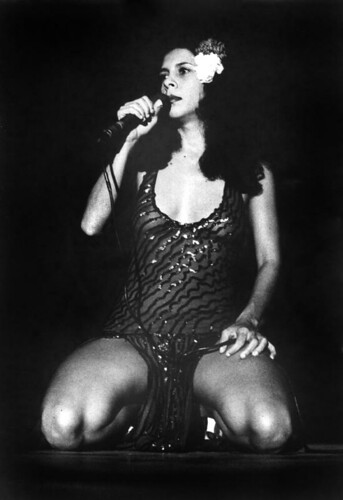- Gal Costa
Their names are Maria da Graça Costa Penna Burgos and Élisabeth-Louise Vigée-Le Brun respectively. In my imagination the two have a great deal of overlap. It has to be down to more than the fact that the music of the former - more commonly known as Gal Costa - provided a musical backdrop for my discovery of the latter during the summer of last year. Never mind the that the two are separated in birth by 160 years, an ocean and a language; by differences of medium, culture and politics; as well as by that essential disjunction between the land of the living and that of the dead. Just listen to Gal's 1971 live recording of "Falsa Baiana", included on Wrasse Records' 2007 compilation Gal Favourites, alongside a reproduction - or, if you have the resources and the time, the original (in the National Gallery, London) - of Vigée-Le Brun's pitch-perfect Self-Portrait in a Silk Hat of 1782; and try telling me that the two pieces don't possess precisely the same atmosphere.

It's an atmosphere of supreme clarity, luminosity, and graceful spontaneity; of what Matthew Arnold might have called 'Sweetness and Light' had he been granted the opportunity to develop an interest in both Rococo painting and Música Popular Brasileira. In Gal's case, this accomplishment seems all the more commendable given its historical context. 1971 saw Brazil suffering under the military dictatorship of Emílio Garrastazu Médici. It also saw Caetano Veloso, Gal's long-term friend and collaborator, still languishing in his London exile for his leadership of the subversive multi-disciplinary Tropicália movement, alongside one Gilberto Gil, later to become Minister of Culture under the Lula administration. Gal's prominent role in this counter-cultural phenomenon puts her at a distance from her French counterpart: as well as gaining admittance to the Académie Royale de Peinture et de Sculpture, Vigée-Le Brun served as court painter to Marie Antoinette for a period of 6 years until 1789, when she was forced to flee France after the Revolutionary forces arrested the royal family. The graceful spontaneity of her self-portrait - executed 7 years before the Revolution - may be a direct result of her priveliged position as a belle of the Ancien Régime; Gal conjures Sweetness and Light out of thin air in a climate of anti-intellectual reprisals, economic catastrophe, official censorship and state-sponsored torture.

These historical factors may be hard to ignore when experiencing the two works together. Never mind. What the two artists share is something more profound, though for this it'll be more helpful to consider a different Gal Costa song. "Meu nome é Gal" was released on the 1969 album Gal. Its Portuguese title translates - you might have guessed - as "My name is Gal". Its lyrics initially read like a personal ad:
Meu nome é Gal
E desejo me corresponder
Com um rapaz que seja o tal
(which translates thus:
My name is Gal
And I wish to make contact
with a boy who would be 'the one'...).
Gal then lists those she admires (Veloso and Gil are top of the list) and sketches a brief profile of herself: 'My name is Gal, I am 24 years old...I believe in God, I like dancing, the cinema'. Simplistic as this may seem, the delivery lends it a real gravitas. By the end of the song, when Gal screams,
Meu nome é Gal
E não faz mal!
(And It's OK!)
It feels like something mildly transcendent has gone on: a powerful act of self-affirmation, perhaps of what Coleridge called the 'Primary Imagination' ('a repetition in the finite mind of the eternal act of creation in the infinite I AM', Biographia Literaria). If this idea seems overly theological, then at least concede that there is something incisive, lucid and invigorating in the way Gal presents casts her own identity. For it is precisely this mode of self-presentation that she shares with Élisabeth-Louise Vigée-Le Brun. Though the painter co-opted the iconography of an earlier painting by Rubens - the 1622-25 work 'Le Chapeau de Paille', also in the National Gallery's collections - for her own self-portrait; she very successfully makes this iconography (and here I risk paraphrasing Simon Cowell) Her Own. She is her own woman, in charge of her own depiction as well as her livelihood. She is neither flippant nor stern; the delicate poise of the ostrich feather in her straw hat is elegantly counterpointed by her firm grip on the tools of her trade, the pallette and the brushes. The presentation holds flair and substance in perfect balance. Incisive, lucid and invigorating.
Though a whole spectrum of ideology may lie between the artistic circles with which these two women chose to afilliate themselves, their trajectories were essentially the same: both eventually attained such prominence within their respective circles that they were able to become not only artistically self-sufficient but self-definitive. Through the myriad overlapping voices of their times, they could shout, 'I am what I am! And it's OK!'
thanks to Anna MacSwan for help with the translations

No comments:
Post a Comment